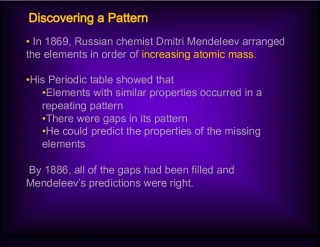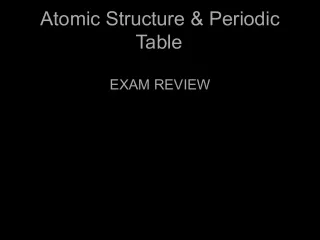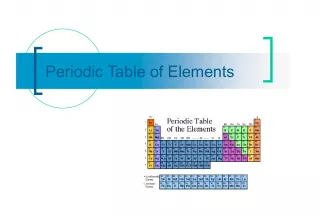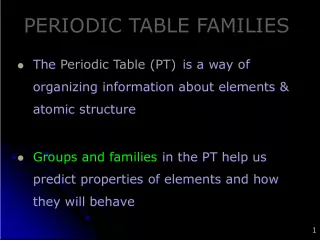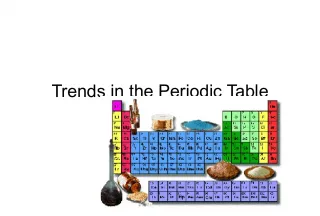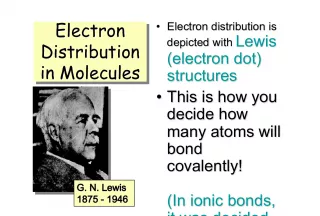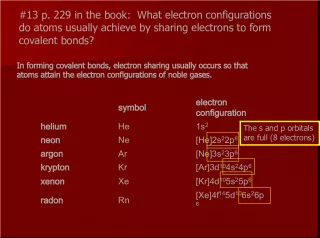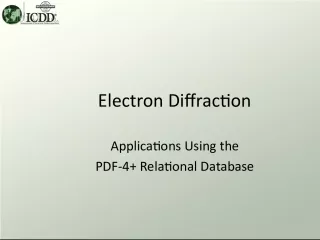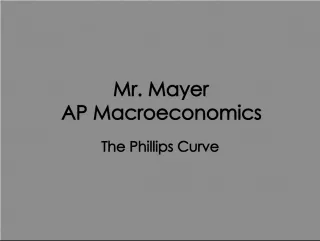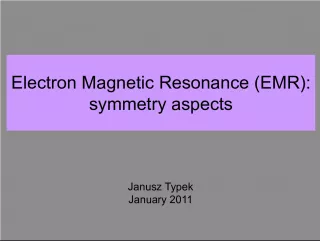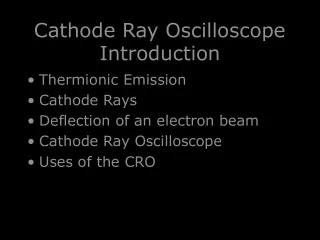The Relationship between Electron Configuration and the Periodic Table


In Chapter 6, the concept of electron configuration is explored in relation to the periodic table. The electron configuration of each element determines its placement within the table, and the number
- Uploaded on | 6 Views
-
 luciano
luciano
About The Relationship between Electron Configuration and the Periodic Table
PowerPoint presentation about 'The Relationship between Electron Configuration and the Periodic Table'. This presentation describes the topic on In Chapter 6, the concept of electron configuration is explored in relation to the periodic table. The electron configuration of each element determines its placement within the table, and the number. The key topics included in this slideshow are . Download this presentation absolutely free.
Presentation Transcript
Slide1Chapter 6
Slide2how does electron configuration relate to the periodic Table?2 10 6 14 1 2 3 4 5 6 7 3 2 4
Slide3Which statement is true? (use Periodic Table)A. Elements in the same column ↕ has same # of outer shell electrons B. Elements in the same row ↔ has same # of outer shell electrons
Slide4produced the first periodic table for the known 63 elementsArrangement: Increasing atomic mass kept similar elements in a column left blanks for unknown elements Interesting observations: Mendeleev predicted the properties of the missing elements.
Slide6Arrangement:Increasing atomic number Interesting observations: Discrepancies in Mendeleev’s table disappeared (Te before I)
Slide8VerticalRow Column Group Family Period
Slide9Same # of occupied energy levels
Slide10Groups or familiesSame # of electrons in their outer orbital Share similar chemical properties
Slide11Metal:• Conducts heat & electricity • Ductile • Malleable • Luster • Solid at room temp. (except Hg) • Forms cations (+) Properties of Metals, Non-metals, & Metalloids Non-Metal: • Brittle • S/ l /g at room temp. • Forms anions (-) Metalloids • Semi-conductors • Properties of nonmetals and metals
Slide12Note: Most elements are _________Metals, non-metals, & metalloids metals
Slide13Main-group elements Also called representative elements ( s- and p- blocks) E- config: regular & consistent Group: same # of val. e-
Slide14InnerTransition Metals
Slide15Hydrogen Most common element in universe charge: 1+ or 1- Alkali Metal (Group 1, except H) Highly reactive with water Soft and can be easily cut Charge:1+ Alkaline-earth metal (Group 2) Less reactive than alkali metals Harder than alkali metals Charge: 2+
Slide16Transition metals (d-block) No identical valence electrons (charge varies) Less reactive than group 1 & 2 Inner Transition metals (f-block) Nuclei are unstable – radioactive (charge varies)
Slide17Halogens (Group 17) Most reactive group of non-metals Likes to react with alkalis to produce salts charge :1-
Slide18Noble gases (Group 18) Low chemical reactivity b/c very stable Outermost energy level is full Does not form ions Glow brightly when an electric discharge is passed through them
Slide19InnerTransition Metals
Slide20Octet rule:atoms are most stable when they have 8 val. e- CATION: (+) ions Alkali Metals: Na loses 1 e- 1 s 2 2 s 2 2 p 6 3 s 1 1 s 2 2 s 2 2 p 6 (Na) (Na+) Bohr Diagram E- config Ne
Slide21ANION: (-) ions Halogens: Cl gains 1 e- 1 s 2 2 s 2 2 p 6 3 s 2 3 p 5 1 s 2 2 s 2 2 p 6 3 s 2 3 p 6 (Cl) (Cl-) Ar
Slide22as you look down a column, the outermost principle energy level__________________. (but the number of valence e - ‘s stays the same) As more and more levels become filled with electrons, the nucleus becomes ______________ effective at attracting the outer electron(s). This is known as the “shielding effect.” (As you look down a column, even though the nucleus theoretically is stronger since it has more protons, it is NOT effective at holding onto the outer electrons.) Which energy level has NO shielding? ____________ Which atom holds onto the outer electron tighter, K or Rb? Why? ____ has one more filled level than ____ and therefore is _____ effective at holding onto the outermost (valence) electron. INCREASES LESS 1 LESS Rb K
Slide23Is the shielding effect an issue with a row?_____Row, Period , Series Val. n=2 n=2 n=2 n=2 n=2 n=2 n=2 n=2 energy level filled ____ ____ ____ ___ ___ ____ ___ ____ Levels The energy level is not changing. What is changing? Is the nucleus getting stronger?_________. Is it effective?________ In a row, ___________ ___________(and not shielding) determines the trend. 1 1 1 1 1 1 1 2 b/c noble gas # of electron & protons YES YES NUCLEAR CHARGE NO
Slide24Recap:Column: the __________ _________ dictates the trends. Row: the increasing strength of the __________ dictates the trends. ELECTRON SHIELDING NUCLEUS
Slide25Distance from nucleus to outer electronsBond radius = ½ distance between nuclei of adjacent atoms.
Slide26Down a Group: Increases Reason: more energy levels more shielding Across a Period: Decreases Reason: More nuclear charge (+) pulls outer most e- closer to nucleus
Slide27Metals tend to _________ electrons and become ____________ions. (gain or lose) positive or negative) ** (metal ions are ___________than metal atoms ) (smaller or larger) Non- metals tend to _______ electrons and become __________ ions. (gain or lose) (positive or negative) ** (non-metal ions are ______________than non-metal atoms ) (smaller or larger) lose positive smaller gain negative larger
Slide28Energy required to remove an electron from an atom or ion (form (+) ion) .
Slide29Down a Group: Decreases (easier to remove an electron) Reason: 1. more energy levels (outermost electrons are farther from nucleus) 2. more shielding (less attraction btw p+ & val. e-) Across a Period : Increases (harder to remove an electron) Reason: 1. more nuclear charge, p+ ↑ 2. radius decreases Electron-shielding remains the same
Slide30Lower down in a column the atoms are larger / smaller and have more attractiveness / shielding so it is easier to remove an e - from the outer shell. It is harder/easier to remove an electron from a small atom with no shielding. It gets harder/easier to remove that electron as you move to the right as it approaches a perfect octet. Which column would be very difficult to go in and remove and electron from? Noble gases So the column with the highest Ionization Energy = Group # 18, Noble gases Ionization Energy pg-10 Circle the correction answer & answer the last 2 questions
Slide31Which element has the least IE? the most?
Slide32the attraction of an atom to a pair of electrons in a bondFluorine has the highest value of “4.0” **EXCEPT NOBLE GASES
Slide33Down a Group: Decreases (less attraction towards bonding e-) Reason: 1. more energy levels 2. more shielding Across a Period: Increases (more attraction towards bonding e-) Reason: 1. radius decreases (val. e- closer to nucleus) 2. nuclear charge increases, p+ ↑
Slide34Fluorine atompulls harder on the shared pair of electrons. They are shared “unevenly” Electronegativity of Fluorine is > , = , < the electronegativity of hydrogen Chlorine atoms share the pair of electrons “evenly” Electronegativity of Chlorine is > , = , < the electronegativity of Chlorine In water, does Hydrogen or Oxygen pull harder on the shared pair of electrons? ____________ Which column does NOT bond with any element (because it has a perfect octet)? ____________________ (No electronegativity values are assigned) NOBLE GASES
Slide35Atomic mass:mass in grams = 1 mole of that element Example: 12 g C = 1 mol C Molecular mass: mass of a molecule = 1 mole of that molecule Example: 32 g O 2 = 1 mol O 2 Diatomic Elements ( BrINClHOF ): Br 2 I 2 N 2 Cl 2 H 2 O 2 F 2 Elements found in pairs
